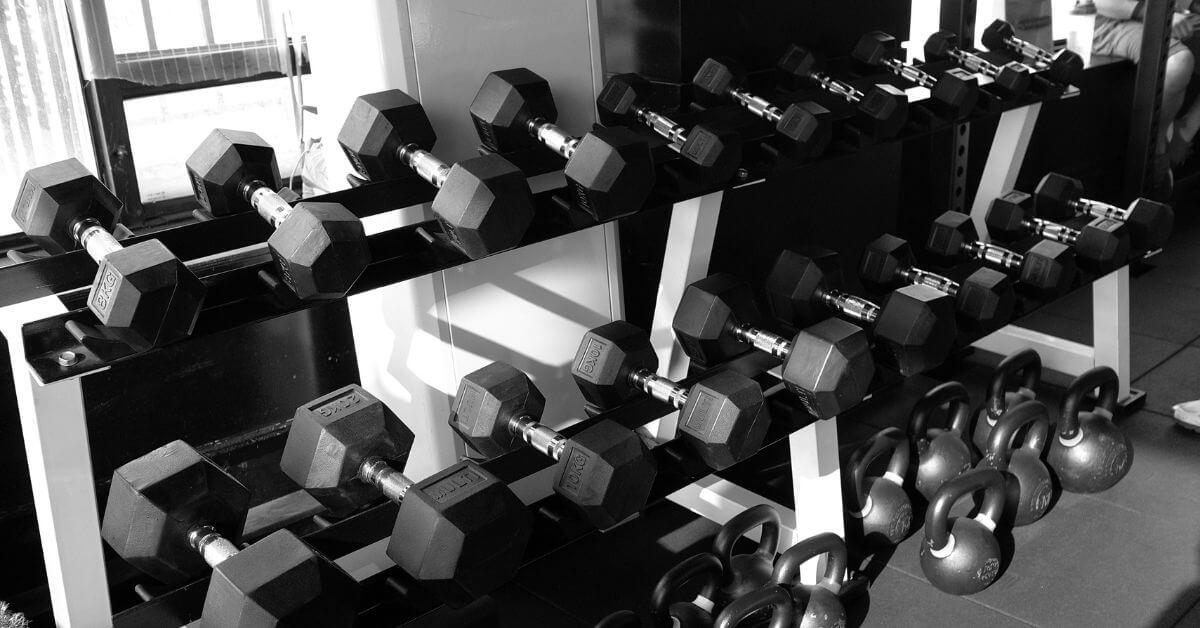When you are just starting with strength training, weightlifting, or resistance training for the first time, knowing how to choose the proper weight and how heavy you should lift in your session might be challenging. Making the appropriate choice here could mean the difference between an incredible and mediocre gym workout after you’ve chosen the type of weight to aim for.
Table of Contents
ToggleYou run the danger of hurting yourself if you push yourself too hard. If you exercise too lightly, your muscles won’t develop already existing tissue further or become properly exhausted. Even experienced lifters must consider their choice of weight in light of the goals they have for their workout.
If you are wondering, “What weight dumbbells should I use male kg” or “What weight dumbbells should I use female kg,” you are not alone. Many beginners struggle with selecting the right dumbbell weight that aligns with their fitness goals and physical capabilities.
Start Building Your Dream Body Today
Ready to elevate your fitness game without falling into the trap of dull, repetitive routines that just don’t deliver? Imagine sculpting your ideal physique and boosting your health, all while still enjoying life’s pleasures, like those irresistible weekend getaways and your aunt’s legendary cheesecake. With our online fitness and nutrition coaching service, you don’t have to compromise. Dive into a personalized fitness journey that blends perfectly with your lifestyle, not against it. Book your completely free discovery consultation today, and take the first step towards a transformation that doesn’t require giving up the joys of life.

“I was skeptical about online fitness coaching, but Functional Body Savage completely changed my perspective. Vanja and Radomir’s personalized approach and attention to detail have helped me achieve goals I never thought possible. I’m stronger, more confident, and grateful for their guidance.”
Emily Thompson, San Francisco, CA
Learn More About Our Online Coaching ServiceQuick Summary
- The dumbbell weight that best serves your aim is one that you can rep between 6 and 15 times.
- Dumbbells weighing between 3-25 pounds (1.4-11.4kg) could be a good option for beginning female lifters who are starting.
- The ideal dumbbell weight for men is 5-50 lbs (2.5-22kg).
How to Choose the Right Dumbbell Weight?
A common question is “what dumbbell weight should I use” for various exercises. For instance, a water bottle with a capacity of 1 liter will weigh about 1 kilogram. A 1 kg set of dumbbells is ideal for your “light” set if you feel that this is heavy enough to perform 10–12 curls. Fill a 5-liter watering can to the top; it should weigh around 5 kg if 1kg feels too simple.
A water bottle with a capacity of 1 liter will weigh about 1 kilogram. A 1 kg set of dumbbells is ideal for your “light” set if you feel that this is heavy enough to perform 10–12 curls. Fill a 5-liter watering can to the top; it should weigh around 5 kg if 1kg feels too simple.
Find a medium-sized plant pot or stuff a backpack with books or water bottles for your medium set. Check the weight of the object you’ve chosen by weighing it on some scales. Can you lift it with both hands above your head? Use it to perform some rowing motions. Is it a bit too easy or too difficult?
Your medium set of dumbbells should be twice (or a little bit more) as heavy as your light set. Dumbbells in your heavy set should weigh about 50% more than those in your medium set.
For instance, if I used a pair of dumbbells weighing 5 kg for my light set to complete arm workouts, my medium set for my upper body would weigh between 12.5 and 15 kg. This means that the weight of my heavy set for leg workouts should be between 20 and 22.5 kg.
1. Evaluate Your Strength
Pick a dumbbell weight appropriate for the workout and your level of expertise. You might need different-weight dumbbells depending on the exercise. You could be able to curl 15 pounds (6.8 kg), for example, if you are performing a simple curl.
However, if you are using dumbbells to perform a squat, you might choose a 20- or 25-pound (9- or 11-kg) set. Like learning a new exercise, you should begin light and concentrate on developing good form before adding weight. Don’t limit yourself to a single set of dumbbells.
Make sure you have various weights for the workouts you want to perform. To accommodate multiple exercises, most beginners should have three sets of dumbbells: a light set, a medium set, and a heavy set.
2. Know Your Goals
Establish your weightlifting objectives. Are you aiming to strengthen a particular muscle group? Perform a better curl? Setting goals will help you choose the right dumbbells. While lighter dumbbells are better for stabilizing muscles to maintain tendons and joints, heavier ones are better for muscular growth.
Generally speaking, a muscle group can lift more weight the bigger it is. For your biceps, triceps, and deltoids, use small to medium dumbbells; for your chest, leg, and back muscles, use medium to big weights.
Before and throughout your dumbbell workout, make a list of your objectives. Doing so can maintain concentration and change your intentions if a goal has been achieved. You might put down, for instance, that you plan to do a set of 10 bicep curls with 30-pound weights over the next month.
How to Choose the Right Dumbbell Weight by Your Goal?
To choose the right dumbbell weight by your goal is the one you can rep between 6-15 times. For strength training, use 15 or 20 pounds of dumbbells (6.8 or 9kg); for endurance, start with at least 20 pounds (9kg).
Choosing the proper dumbbell weight is crucial, so don’t skip this step. Dumbbells will be required for various activities, skill levels, and physical capabilities. Always remember that it is preferable to begin light and gradually build weight. Starting too heavy could result in strain or harm.
Dumbbell Size for Strength
People who want to gain strength should select a dumbbell that is heavy enough to allow a maximum of 6 repetitions. You should start with a lightweight exercise to become accustomed to intense exercise. Consider starting with 10 pounds (4.5kg) for hand workouts and progressively increasing it to 15 or 20 pounds (6.8 or 9kg).
When pondering “what dumbbell weight should I use kg” for strength gains, it’s essential to start with a manageable weight and progressively increase it as your strength improves.
The weight you have chosen for your strength workout is correct till you can lift it 1-6 times. Take a 3-5 minute pause between sets of exercises to allow the muscles to fully recover so that the next session won’t be hindered. However, you should warm up properly and gradually increase the weight to its maximum before lifting large objects.
Dumbbell Size for Hypertrophy
The ideal dumbbell set weighs 5-50 lbs (2.5-22kg). This will allow you to gradually increase the weight for the various workouts while still successfully targeting each muscle area for hypertrophy.
Additionally, you will be able to develop your strength by using heavier weights for fewer repetitions. Work on your strength also because doing so will enable you to add additional muscle. They work together seamlessly.
Dumbbell Size for Weight Loss
This one includes 5-25lbs (2-12kg), which is ideal for weight loss and hypertrophy, or, in other words, for men to get thin and shredded.
For women, a weight range of 3–10 lbs (1–5kg) is ideal for fat loss and lean muscle gain. If you want to go a little heavier for some leg-based complex motions, get 20lb (9kg or 10kg).
If you’re curious about “what size dumbbells should I buy” for your fitness goals, consider starting with lighter weights for endurance and gradually increasing them as you build muscle and strength.
Dumbbell Size for Endurance
Do more repetitions with lighter weights if you want to concentrate on building endurance (perhaps 12 to 50 repetitions). And if you want to increase your muscle endurance, use dumbbells that weigh at least 20 pounds (9kg). Lighter weights are also acceptable.
Depending on how hard you exercise for endurance, you may be able to benefit from it every day of the week. You may lift more weight with endurance while consuming less energy daily.
Dumbbell Size for Power
If you are an intermediate to advanced lifter, it would be ideal to have a set of dumbbells that range from 10 lbs to 70lb-100lbs (5-50kg).
For squats, the total weight does not equal the barbell lifts because your arms must hold the weight rather than your back, so if you are really strong, aim for the 100lb (50kg) maximum. Dumbbells also demand additional stability.
Dumbbell Size for Toning
Start with 2- to 3-pound dumbbells and work your way up to 5- to 10-pound dumbbells for ladies and 10- to 20-pound dumbbells for men to tone your arm muscles. Increase the weights once you can complete 12 to 15 reps with little effort.
You will get the most toning effects by including high-rep, low-weight, moderate-weight, and lower-rep sets. You constantly put your muscles under pressure to adapt to the load by changing the rep range and the weight you lift.
Dumbbell curls, hammer curls, overhead triceps extensions, kickbacks, triceps dips, and incline dumbbell curls are a few excellent exercises.
Do 12 to 15 repetitions of dumbbell biceps curls, for instance, then 12 to 15 repetitions of overhead triceps extensions, and rest for 30 seconds.
How to Choose the Right Dumbbell Weight by Exercise?
To choose the right dumbbell weight by exercise, use Goldilocks weight. That means weight should not be too heavy nor too lightweight.
Here are 4 rules to follow when choosing your Goldilocks weight.
Rule 1: Begin by Addressing the Weight You Are Already Carrying
To learn movements with perfect form and alignment, start with just your body weight. Once you are confident in your form, you can increase weight.
Rule 2: Always Make the Final Few Reps Challenging
The weight is too light if you effortlessly complete all of your reps and feel that you could have performed an additional set. If, however, you find it challenging to keep good form or cannot complete your set, the weight is too heavy. A little trial and error are required to find your sweet spot.
Rule 3: Choosing the Right Weight Is Affected by the Exercise You Do
Your utilization of weight should be in line with the power of your muscles. For instance, you should use a larger weight for squats than shoulder raises because your glutes are stronger than your shoulders.
Rule 4: Accept a Challenge Wholeheartedly
It is best to increase the weight by a pound or two-no more than five when you feel ready.
Continue experimenting if you need to use momentum, experience any pain, or can’t move through the entire range of motion. Your Goldilock weight has not yet been discovered.
Expert Shares His Approach to Choosing the Right Weight
In a
YouTube video
▶️ Estimated watch time: 8 min
💡 Key benefit: Learn how to choose the right workout weight
,
Adam Schafer, certified by the National Academy of Sports Medicine and the National Council on Strength and Fitness, shares his approach to choosing the right weight for a workout:
“The number one question on this channel that I get asked is how do I choose the right weight. I don’t think there is a wrong way to do this. How I teach my clients how to do this is simply this: Whatever your program says, depending on what you are following, you may have a rep range that says five repetitions, or it says ten repetitions or fifteen. Those are the most common rep ranges that you see in programs. First of all, that’s just a generalization. Give yourself 2 repetitions north or south of the number that your program recommends. Also, as soon as your form starts breaking apart, you are likely beyond the rep range that you want to be at. This means you should primarily use the number of reps and your exercise form to guide you on the road to selecting the proper weight for a particular exercise.”
Lower-Body Exercises
The quadriceps, adductors, calves, and glutes are some of the muscles in the lower body. Squats and other compound dumbbell leg workouts require the cooperation of these muscles to accomplish a rep. You should utilize a slightly to considerably heavier dumbbell when your lower body muscles cooperate.
Upper-Body Exercises
The main upper body muscles are the chest, triceps, deltoids, forearms, biceps, back, and lats. You can lift more weight with upper-body exercises like presses and rows that work numerous muscular groups than with, for example, triceps extensions that only work the small triceps muscles. In general, because the lats and upper back are larger and more powerful muscles than the chest, you should be able to lift more weight than you can press.
Isolation vs Compound Exercises
Exercises like biceps curls and lateral raises isolate a single muscle. Workouts like dumbbell bench presses, dumbbell deadlifts, and shoulder presses are compound exercises that work for two or more muscle groups and increase muscle mass. You should be able to use heavier weights than you would for isolation exercises like lateral raises because compound movements work numerous muscle groups.
Dumbbell Weight for Men
The optimal dumbbell set would be a weight range of 5-50 lbs (2.5-22kg). This will allow you to gradually increase the weight for the various workouts while successfully targeting each muscle area for growth.
Additionally, you will be able to develop your strength, which requires using a heavier weight for fewer repetitions. Strength training is crucial since it will enable you to add more muscle. They complement one another.
A 5-50lb (2.5-22kg) dumbbell set will often increase in 5lb steps, which is ideal. Also, keep in mind that you are purchasing two of each weight. Although one dumbbell can be used in various fantastic ways, you should have two of each size.
Dumbbell Weight for Women
Beginner female lifters who want to gain muscle might think about using dumbbells that weigh between 3 and 25 pounds (1.4-11.4kg). Although you may always add more weight later, this should offer you the ideal base for most beginner lifts and gains.
For those still asking “what weight dumbbells should I use female” or “what weight dumbbells should I use male kg,” a good rule of thumb is to start with lighter weights to perfect your form and then gradually increase the weight as you progress.
Read our guide on the 10 best dumbbells for women in 2025 to pick a high-quality and appropriate dumbbell for your personal needs.
Always remember that sculpting and toning, Not bulking, will result from performing more reps with less/lighter weight. Quality comes first. Never compromise form to complete additional repetitions. You will cause yourself harm. It is not intelligent to do. Avoid doing it.
It is crucial to stretch! Vital, necessary, and demanded. Just as when you do cardio, stretch your muscles before and after resistance training.
What Size Dumbbells Should a Beginner Use?
Beginners should use up to 5kg of dumbbells. With this weight, you can see the improvement and development of the muscles.
The “best dumbbell weight for beginners” typically ranges from 1-5 kg. This range allows you to master the movements and build a solid foundation without risking injury.
Exercises for your upper body, in particular, rapidly become too demanding when you add even a tiny amount of weight. You can often lift greater weight during exercises for your lower body, such as squats. Make sure you gradually increase the weight. Before utilizing heavier weights, increase the number of reps and concentrate on using the proper technique first.
How Heavy Should Dumbbells Be for Seniors?
Dumbbells for seniors should weigh 15 pounds (6.8 kg) for lower body exercises and 5-or 7.5-pound (2.3- or 3.4-kg) dumbbells for the upper body. Each workout requires a different amount of weight.
After all, the majority of individuals are capable of lifting more significant amounts of weight while squatting. Selecting a weight you can comfortably regulate is more crucial than specific numbers. You can probably increase the weight a little if, after completing a set, you feel like doing another right away.
Your dumbbells are too heavy if your form falters toward the end of a session. You must also gradually increase the weight you lift or the number of sets and repetitions you perform to gain muscle and strength over time. Make it a point to increase the difficulty of your dumbbell exercises anytime they begin to feel too easy.
Best Dumbbell Size for Home
Complete beginners, who have only trained at home with no supervision from a personal trainer, should begin with weights ranging from 2 kg-6kg. If you start too heavy, you risk losing motivation when you find it difficult to exercise.
You could be prepared to advance to medium-sized weights if you have done bodyweight training for some time and feel pretty strong. You could choose dumbbells that weigh between 6 and 10 kg for that. Anything above that would be considered “heavy” for your home workouts — ideal for people who have switched from gym-based training to home workouts.
Dumbbells might seem easy for those who frequently squat more than 40 kg at the gym, but remember that barbells cover a different terrain. When you squat with a dumbbell, you must transfer the weight to your shoulders or hold it at your chest; however, the racks in the gym are made to eliminate this additional strain.
Fixed Dumbbells vs Adjustable Dumbbells
It can be hard to decide whether to buy fixed or adjustable dumbbells. Whether adjustable or not, all types of dumbbells have some restrictions. Both can give you a full-body exercise and support your strength training regimen, but they differ in functionality and pricing.
The plus side is that you can use any approach and still benefit from strength training. There is no one best type of dumbbell. The one that best meets your unique demands is the one that is ideal for you.
Fixed Dumbbell Set
There is no flexibility when it comes to fixed weights. A 50-pound fixed dumbbell will always weigh 50 pounds. The dumbbell is constructed from a solid block that has undergone rigorous molding. This is why these dumbbells are popular among lifters.
There is no need to alter the weight manually. Just take them up and keep going.
Fixed-weight dumbbells are exceptionally strong and secure. You can hold them easily in your hands.
The fact that these dumbbells cannot be adjusted doesn’t matter when lifting weights at the gym because there will typically be a full rack of weights accessible for you to choose from right away.
But fixed weights might become a headache if you have a home gym. There might not be enough storage for the other dumbbells you require.
Because you have to purchase more weight, it usually costs more.
Adjustable Dumbbells
Adjustable dumbbells are a more space-efficient option for your home gym. Using any of the various mechanisms built into the gadget, such as a pin, dial, or lever, you can modify the weight the object places on your handle when you pick it up. Switching between weights is much more practicable with adjustable dumbbells that have been more recently developed.
If the weights on your dumbbells are fixed and non-adjustable, you must buy each weight denomination separately. Adjustable weights are a good option for people who value their space or live in a major city with limited space for exercise equipment.
A smaller home gym is highly advantageous because you only need one piece of equipment. The way these tools feel in the hands does not appeal to everyone. They occasionally get a rattly or off-balance feeling. Nevertheless, it is unmatched in terms of cost and available space.
How to Know if You Are Using the Right Dumbbell Weight?
To know if you are using the right dumbbell weight, your reps should not feel too easy or hard. At the end of the set, you shouldn’t be dropping weights to the floor from exhaustion.
But if you complete those rep counts quickly, you should increase the weights. It is appropriate to increase the weights if you can complete 15-20 reps without discomfort. Similarly, the weights are probably too heavy if you can’t complete 10 reps without feeling like you will collapse.
By the conclusion of 15 reps, you should be almost completely exhausted, but you should still be able to finish them properly. Therefore, the final two reps should be demanding but in a good way.
FAQs
What Size Dumbbells Should I Start With?
You should start with a set of two 10- to 20-pound dumbbells. However, it will be necessary to use bigger weights and fewer reps to gain muscle mass.
Are 1KG Dumbbells Effective?
Yes, 1kg dumbbells are effective. Because they are light, they aid in muscle toning, fat loss, warming up, and getting accustomed to specific exercises, and they serve as an excellent start to weightlifting with dumbbells.
What Weight Dumbbells Should I Use to Tone My Arms?
You should use 2- to 3-pound dumbbells to tone your arms. Increase the weights once you can complete 12 to 15 reps with little effort.
Can I Lose Arm Fat With Dumbbells?
Yes, you can lose arm fat with dumbbells. Following a diet and upper arms exercise regimen, you can tone arm fat in 4-6 weeks.
What Is the Best Dumbbell Size?
Best dumbbell size is 20kg. This weight is perfect for working muscle groups to build strength, definition, and size.
You should utilize dumbbells to strengthen your upper body and arms. They can be added to any workout to build muscles or make an action more difficult, for instance, including a dumbbell into a regular walking lunge.
The best dumbbells to buy are those with a knurled grip because they offer a firm grasp for lifting weights.
Let me know what you hope to accomplish with dumbbells in the following two months.
Start Building Your Dream Body Today
Ready to elevate your fitness game without falling into the trap of dull, repetitive routines that just don’t deliver? Imagine sculpting your ideal physique and boosting your health, all while still enjoying life’s pleasures, like those irresistible weekend getaways and your aunt’s legendary cheesecake. With our online fitness and nutrition coaching service, you don’t have to compromise. Dive into a personalized fitness journey that blends perfectly with your lifestyle, not against it. Book your completely free discovery consultation today, and take the first step towards a transformation that doesn’t require giving up the joys of life.

“I was skeptical about online fitness coaching, but Functional Body Savage completely changed my perspective. Vanja and Radomir’s personalized approach and attention to detail have helped me achieve goals I never thought possible. I’m stronger, more confident, and grateful for their guidance.”
Emily Thompson, San Francisco, CA
Learn More About Our Online Coaching Service




